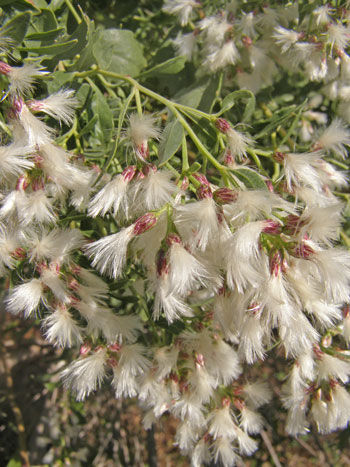A plant that’s on the move
By Ken Moore
Flora Columnist
“What’s that white-flowered shrub I see everywhere along the roadsides?â€
If you dare stop your car to take a closer look, you will observe that those shrubs are not in flower at all. That brilliant white effect is created by the fluffy seed heads of Sea-myrtle, Baccharis halimifolia. Dense clusters of tiny seed with parachute-like threads or hairs are characteristic of many of the plants in the composite or aster family. The Sea-myrtle is one of the very few woody plants in the aster family that occur in North Carolina.
Along roadsides, long stretches of the white form of this shrub are interrupted by patches of less-noticeable male plants. This native shrub is “dioecious.†You can impress your non-botanical friends with this term, which describes plants that bear male and female flowers on separate plants. Like the red-berried hollies, only the female plants become noticeable by bearing fruit.
This shrub of the outer coastal dunes and salt marsh shrub thickets was not locally so evident years ago. The “bible†of plant identification for the past several decades, Manual of the Vascular Flora of the Carolinas by Radford, Ahles and Bell, described this shrub thusly: “Believed to have been restricted at one time to the outer coastal plain, but now widely spread inland.†The newest guide, Flora of the Carolinas, Virginia, and Georgia by Alan Weakley, still in preparation, updates the shrub’s habitat as “… plants of the outer Coastal Plain and also spread extensively inland as a weed …†As a botany student back in the mid-1960s, I don’t recall ever seeing it locally.
Recently, I voiced concern to a plant ecologist about the very rapid westward movement of Sea-myrtle. Was it likely to become a terrible invasive like Chinese Privet, Ligustrum sinense and Spring Silverberry, Eleagnus umbellata? I was advised that Sea-myrtle would only take hold on disturbed sites.
The Interstate 40 corridor is such a site. And since it opened, Sea-myrtle has taken advantage of it as a fast lane from the coast to the mountains. In our areas, it is so thick along roadsides and edges of abandoned fields that it is literally pushing out wildflowers and other natives like dogwoods, Cornus florida, and redbuds, Cercis canadensis. Within the last decade I have watched it move west along the interstate to the very entrance of Asheville. Air-borne seeds have only to land on disturbed ground for opportunities to grow. And these days our landscape is becoming more and more disturbed. A good reason to support our local Triangle Land Conservancy and similar land conservation groups is that an undisturbed habitat is the best protection against invasion of “outsider†plants.
However you choose to view this invasion, reduce your pace during the next week to take a closer look at Sea-myrtle, invisible most of the year and so brilliantly evident right now. If you really are too busy for a “time out,†then just wait a few years. You will most likely have Sea-myrtle show up on your roadside or in your garden. I have one; it showed up three years ago and now it’s taller than the tool shed. But it’s a lone male and not spectacular like all those females.
Email Ken Moore at flora@carrborocitizen.com. Find previous Ken Moore Citizen columns at The Annotated Flora (carrborocitizen.com/flora).



Comments are closed.